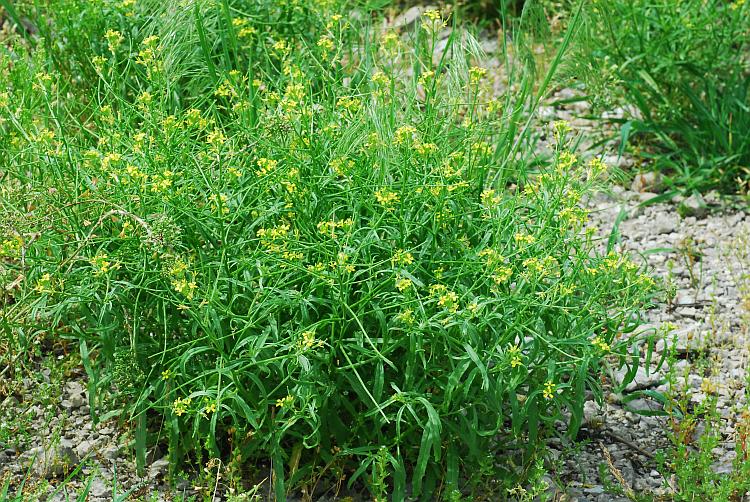Erysimum repandum L.
Bushy Wallflower

Introduced
CC = *
CW = 5
MOC = 41
© SRTurner
Erysimum repandum L.Bushy Wallflower | |
 |
Introduced CC = * CW = 5 MOC = 41 |
© SRTurner |
|
Family - Brassicaceae Habit - Perennial forb from a stout taproot. Stems - 1 per plant, variously spreading to erect, 7-50 cm, usually unbranched below the inflorescence, pubescent with appressed 2- and 3-branched hairs.
Leaves - Basal and alternate, simple, sessile. Blades 2-8 cm long, linear to narrowly oblanceolate, the margins usually entire or the lower leaves commonly shallowly and broadly toothed, rarely pinnately lobed, pubescent with appressed 2- and 3-branched hairs.
Inflorescences - Panicles or racemes at branch tips.
Flowers - Sepals 4, 4-6 mm long, narrowly oblong, erect, green, hairy. Petals 4, 6-8 mm long, unlobed, light yellow to yellow, often grading to whitish at the base. Styles 0.5-2.0 mm long.
Fruits - Siliques, loosely ascending or spreading, 3-8 cm long, usually noticeably 4-angled in cross-section, pubescent with 2-branched hairs, the stalks 2-4 mm long, stout and about as wide as the fruits. Seeds 0.9-1.1 mm long, oblong-elliptic in outline, somewhat flattened, not winged.
Flowering - March - June. Habitat - Roadsides, fields, pond margins, open disturbed areas. Origin - Native to Europe. Lookalikes - Erysimum inconspicuum, E. cheiranthoides. Other info. - This is an extremely variable plant. Established late-season specimens can be branched and bushy, as in the habit photo at the top of this page, but young plants early in the season can flower when only a few inches high with a single erect stem. The species is found in scattered locations in Missouri, most commonly in counties bordering the Missouri and Mississippi Rivers. It is also found across most of the continental U.S. It is easily identified by its generally weedy habit and small yellow flowers in the Brassicaceae pattern. It can be distinguished from its lookalikes by its stout fruit stalks, which are similar in diameter to the fruits (see image above). Photographs taken at the Kansas City Zoo, 4-20-00, and at Eagle Bluffs Conservation Area, Boone County, MO., 4-11-04 (DETenaglia); also at Marais Temps Clair Conservation Area, St. Charles County, MO, 5-4-2015 and 4-9-2019 (SRTurner). |